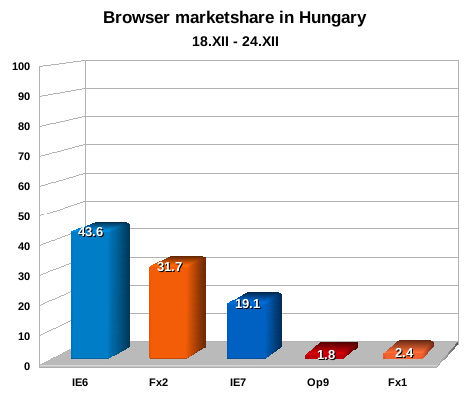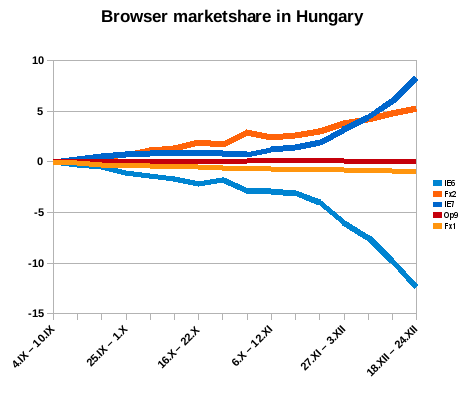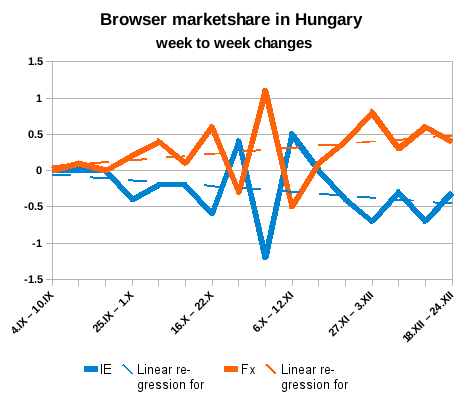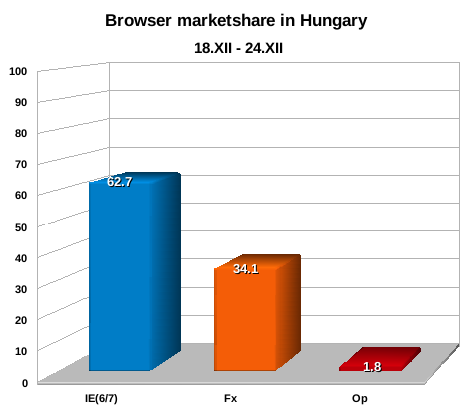The third part of this summary focuses on Hungary. (part 1 – Poland, part 2 – Czech Republic, part 4 – Lithuania, part 5 – Ukraine)
Population: 10 mln
Internet users: 3 mln (30%)
Hungary is similar in size to Czech Republic, but has fewer Internet users (ratio is similar to Poland – 30%). Usually in Eastern Europe, the lower level of the Internet connection saturation means that the market is yet waiting for it’s boom, and it’s about to begin. Hungary and Poland are both members of European Union, and in both cases the reason for such a low Internet penetration is connection price. In Poland for 512 Kb (Neostrada TP), I pay the price that in UK people pay for 8 Mb (BT Total Broadband). With the open market, we’re facing the prices to go down and I expect it’ll unblock the boom this year.
Hungary has it’s community HQ located at mozilla.fsf.hu.
Hungary is yet another good news for Mozilla, with over 34% of the market share owned by Firefox and less than 2/3rd by IE.
Overall, Gecko has 34.9% and IE 62.9%, which places Hungary in between Poland and Czech Rep. in terms of Firefox adoption, which confirms the results from XiTi monitor.
 The same results but separated by version, are revealing the IE7’s adoption which is much more similar to Poland than Czech Republic. It confirms that Hungarian IT market is slower adopting new technologies than Czech one.
The same results but separated by version, are revealing the IE7’s adoption which is much more similar to Poland than Czech Republic. It confirms that Hungarian IT market is slower adopting new technologies than Czech one.
Among those three countries, Vista has the highest share in Czech (5.3%), Poland has 4.5%, while in Hungary it’s just 3.1%.
This market is also less lucky for Opera, which stands with just 1.8%.
In all three countries, IE6 is around 44% point right now (43.6 in Hungary and Poland, and 44.6% in Czech Rep.). Does it mean that we’re about to the end of IE6 domination?
Sorry, no. But first let’s see how the browser war looked like during last 4 month in Hungary.
Woa! Over 4% gain for Firefox!
And again, as in case of previously analyzed countries – the trend is very clear. IE lost 4%, Firefox gained exactly the same amount. Opera holds its ground.
It’s the highest conversion ratio among all 5 countries. Exactly 4.3%, while in the same time IE has lost 4.1%, and Opera has gained 0.1%.
It’s important to notice the difference between how the line looks here, and in case of Czech market. The line there has a very different nature, that in result gave us a very different regression line in the week to week graph. The conversion rate was raising there, while here, it seems to be stable. In result it should give us steady regression line later. We’ll see.
Once we know, that exactly one year after IE7 and Firefox 2 have been released, Firefox is still taking market share from IE in Hungary, another very important information for anyone who’s into browser market share of Europe
 So, how does it look in case of IE7 adoption?
So, how does it look in case of IE7 adoption?
It’s finally getting here. For over 3 months IE7 remained at the same place, which is shocking for me. We’re talking about the browser that is the major upgrade after 6 years. The upgrade is marked as a security one. It’s a default web browser on the operating system that has highest promotion market ever seen and is currently most important product for the biggest IT company in the world. How the hell could it not be the tremendous success?
Well… There were two things that balanced the suspected instant boom. As we saw in case of the polish emigrants, IE7 was even below the 0-line there for a pretty long time. It means that it was loosing market. The only reason I can find is that there is a group of users who are refusing to use IE7 after trying it.
Same could happen here. The second reason is the illegal Windows rate which is much higher here than in US, or Western Europe. Microsoft offered IE7 only to legal users of Windows. Microsoft removed the blocker on October the 5th. The moment when IE7 starts gaining market is a mid November, so it was rather not the only reason. I tend to believe that the combination of those factors, pressure that Microsoft makes on resellers to sell machines with Vista and pushing users to upgrade by windows update system simply overrun the factors that prevented them from upgrading. Another reason might be that websites were incompatible with IE7 and it took time before webmasters upgraded. Of course there might be other reasons that are pushing users to upgrade, or blocking them from upgrading, but no matter if I’m right or wrong, the fact is that IE7 and Firefox 2 are gaining market share in Hungary right now:)
 In the week to week graph, we can see that even if visually it looked like if Firefox is linear, in reality Firefox is gaining market faster than 4 months ago.
In the week to week graph, we can see that even if visually it looked like if Firefox is linear, in reality Firefox is gaining market faster than 4 months ago.
Another thing that can be observed here is that the fluctuations are smaller now, and with each week during last one and a half month, Firefox was taking around 0.4% of the market share from IE.
Another good news? Yea, but it’s not going to be like that with all countries that I analyzed. For now, what we can say is that despite of the starting point, the direction is common for Poland, Czech Republic and Hungary. With a bit different speeds, Firefox is gaining market share from IE, and users who stay with IE are upgrading to IE7 but it’s a slow process.
I remember that 2 years ago, at FOSDEM 2006, Paul Kim gave a talk at Mozilla Dev Room, about marketing strategy of Mozilla. It was obvious to all community members gathered there, that the biggest question mark in those equations was how the market will react to IE7. What will Microsoft do. Mozilla was worried that Microsoft will play unfair – we saw that before, many Mozilla employees remember that times. During the small talks that happened latter, one of the most interesting points was that the biggest worry is that IE7 will be very pretty, with nice UI, and terrible rendering engine with horrible standard support. That Microsoft will convert users to IE7, and block the web from progressing for another 6 years. Fortunately it didn’t happen. IE8 is going to be released probably in early 2009, IE7 has a bit better standard support, and it’s UI is not something they should be proud of. Another tune during those small talks was that it is possible. That Microsoft will promote IE7 so aggressivly that unintentionally it’ll point users attention to the very basic fact that they have a web browser, and the browser might be chosen. Look at these graphs and draw your conclusions.


